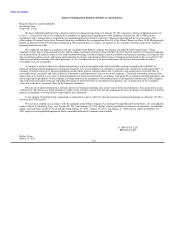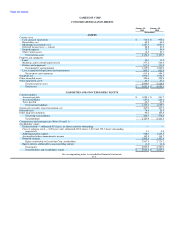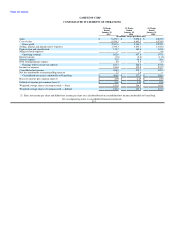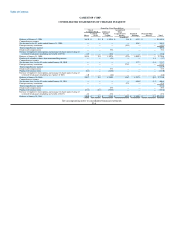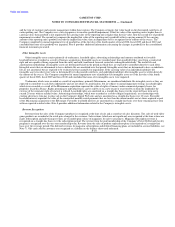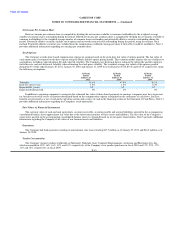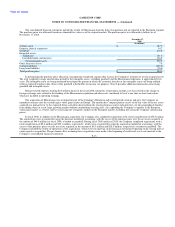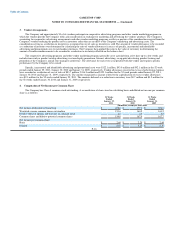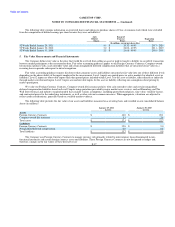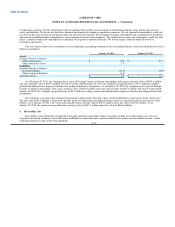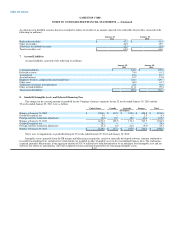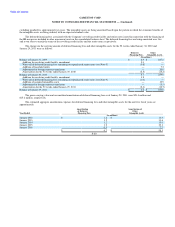GameStop 2010 Annual Report Download - page 80
Download and view the complete annual report
Please find page 80 of the 2010 GameStop annual report below. You can navigate through the pages in the report by either clicking on the pages listed below, or by using the keyword search tool below to find specific information within the annual report.
Table of Contents
GAMESTOP CORP.
NOTES TO CONSOLIDATED FINANCIAL STATEMENTS — (Continued)
and the type of customer and separate management within those regions. The Company estimates fair value based on the discounted cash flows of
each reporting unit. The Company uses a two-step process to measure goodwill impairment. If the fair value of the reporting unit is higher than its
carrying value, then goodwill is not impaired. If the carrying value of the reporting unit is higher than the fair value, then the second test of goodwill
impairment is needed. The second test compares the implied fair value of the reporting unit's goodwill with its carrying amount. If the carrying
amount of the reporting unit's goodwill exceeds the implied fair value, then an impairment loss is recognized in the amount of the excess. The
Company completed its annual impairment test of goodwill as of the first day of the fourth quarter of fiscal 2008, fiscal 2009 and fiscal 2010 and
concluded that none of its goodwill was impaired. Note 8 provides additional information concerning the changes in goodwill for the consolidated
financial statements presented.
Other Intangible Assets
Other intangible assets consist primarily of tradenames, leasehold rights, advertising relationships and amounts attributed to favorable
leasehold interests recorded as a result of business acquisitions. Intangible assets are recorded apart from goodwill if they arise from a contractual
right and are capable of being separated from the entity and sold, transferred, licensed, rented or exchanged individually. The useful life and
amortization methodology of intangible assets are determined based on the period in which they are expected to contribute directly to cash flows.
Intangible assets that are determined to have a definite life are amortized over that period. Intangible assets that are determined to have an indefinite
life are not amortized, but are required to be evaluated at least annually for impairment. If the carrying value of an individual indefinite-life
intangible asset exceeds its fair value as determined by its discounted cash flows, such individual indefinite-life intangible asset is written down by
the amount of the excess. The Company completed its annual impairment tests of indefinite-life intangible assets as of the first day of the fourth
quarter of fiscal 2008, fiscal 2009 and fiscal 2010 and concluded that none of its intangible assets were impaired.
Tradenames which were recorded as a result of acquisitions, primarily Micromania, are considered indefinite life intangible assets as they are
expected to contribute to cash flows indefinitely and are not subject to amortization, but are subject to annual impairment testing. Leasehold rights
which were recorded as a result of the Micromania acquisition represent the value of rights of tenancy under commercial property leases for
properties located in France. Rights pertaining to individual leases can be sold by us to a new tenant or recovered by us from the landlord if the
exercise of the automatic right of renewal is refused. Leasehold rights are amortized on a straight-line basis over the expected lease term not to
exceed 20 years with no residual value. Advertising relationships, which were recorded as a result of digital acquisitions, are relationships with
existing advertisers who pay to place ads on the Company's digital Web sites and are amortized on a straight-line basis over 10 years. Favorable
leasehold interests represent the value of the contractual monthly rental payments that are less than the current market rent at stores acquired as part
of the Micromania acquisition or the EB merger. Favorable leasehold interests are amortized on a straight-line basis over their remaining lease term
with no expected residual value. Note 8 provides additional information related to the Company's intangible assets.
Revenue Recognition
Revenue from the sales of the Company's products is recognized at the time of sale and is stated net of sales discounts. The sales of used video
game products are recorded at the retail price charged to the customer. Sales returns (which are not significant) are recognized at the time returns are
made. Subscription and advertising revenues are recorded upon release of magazines for sale to consumers. Magazine subscription revenue is
recognized on a straight-line basis over the subscription period. The revenue from the paid membership of the Company's PowerUp Rewards loyalty
program is recognized over the one-year membership term. Revenue from the sales of product replacement plans is recognized on a straight-line
basis over the coverage period. The deferred revenues for magazine subscriptions and deferred financing plans are included in accrued liabilities (see
Note 7). Gift cards sold to customers are recognized as a liability on the balance sheet until redeemed.
F-10





